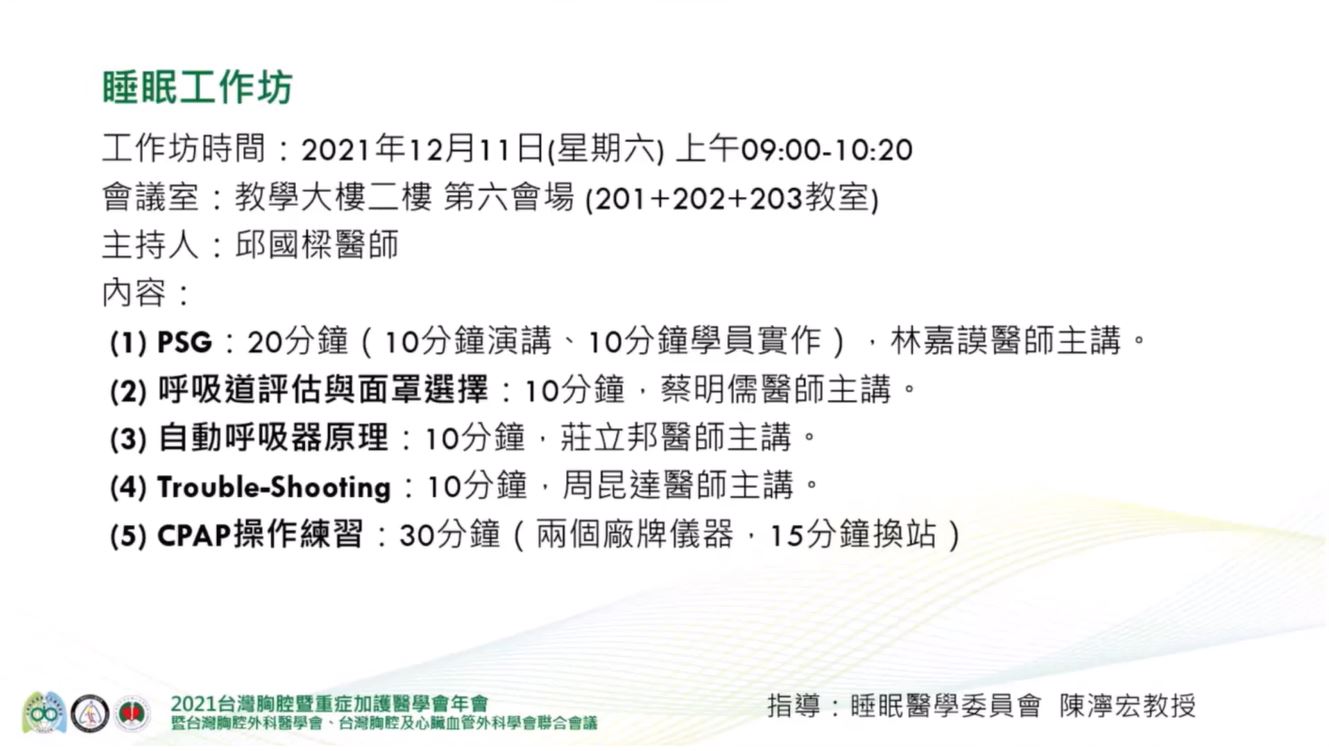
影片由台灣胸腔暨重症加護醫學會提供。
Basic sleep medicine hand-on course: PSG scoring and upper airway evaluation
林 嘉謨 主任 / Chia-Mo Lin, M.D.
Director, Division of Pulmonary Medicine, Department of Internal Medicine, Shin Kong Memorial Hospital
Abstract
從 PSG 基本判讀 sleep onset, REM onset 開始,到正常睡眠結構的解析,之後方能了解何謂異常睡眠結構及其與睡眠品質不佳的關係,最後再帶入睡眠上呼吸道評估技巧,希望能幫助找到正確睡眠呼吸治療的方向。
Basic sleep medicine hand-on practice: PSG and PAP therapy
蔡 明儒 主任 / Ming-Ju Tsai, M.D., Ph.D.
Attending Physician, Division of Pulmonary and Critical Care Medicine, Kaohsiung Medical University Hospital
Director, Medical records room,Kaohsiung Medical University Hospital
Associate Professor, School of Medicine, College of Medicine, Kaohsiung Medical University, Kaohsiung, Taiwan
Abstract
Sleep disordered breathing, particularly sleep apnea syndrome, is a major sleep disorder. Polysomnography (PSG) is the major diagnostic exam. Positive airway pressure (PAP) therapy, including CPAP, APAP, BiPAP or NIV, are powerful tools for the treatment of sleep disordered breathing. In this hand-on practice course, we will discuss about the key concepts of PSG, and the evaluation and application of PAP therapy for the patients.
Sleep Hand on course: CPAP, APAP, BiPAP, Home NIV
莊 立邦 醫師 / Li-Pang Chuang, M.D., Ph.D.
Director, Sleep Center, Chang Gung Memorial Hospital, Taoyuan
Attending Physician, Thoracic Medicine, Chang Gung Memorial Hospital, Linkou
Assistant Professor, School of Medicine, Chang Gung University
Abstract
Obstructive sleep apnea (OSA), defined as repeated episodes of obstructive apnea and hypopnea during sleep, together with symptoms of daytime sleepiness or frequently altered cardiopulmonary function, affects at least 5% of the general population. OSA results in intermittent hypoxia (IH) and sleep fragmentation with neurocognitive dysfunction and cardiovascular disease as the major sequelae.
There are several treatment methods, including ventilator, oral appliance and surgery, etc., each one has different advantages and disadvantages. However, according to the American Academy of Sleep Medicine's treatment guidelines for obstructive sleep apnea, the current first-choice treatment is the use of positive airway pressure ventilator.
This speech is a continuation of the core sleep curriculum in August of this year (2021). It mainly focuses on the practical hand on of sleep ventilators, which includes continue positive airway pressure ventilator (CPAP), automatic positive airway pressure ventilator (APAP), bi-level positive airway pressure ventilator (BiPAP), and non-invasive ventilator (NIV) used in home based. I wish that in this 30-minutes talk, the listeners can get relevant concepts and gains in this field.
Sleep Hand on course: PSG, CPAP, APAP, BiPAP, Home NIV
周 昆達 醫師 / Kun-Ta Chou, M.D., Ph.D.
Director, Division of Clinical Respiratory Physiology, Department of Chest Medicine, Taipei Veterans General Hospital
Attending Physician, Department of Chest Medicine, Taipei Veterans General Hospital
Associate Professor, School of Medicine, National Yang Ming Chiao Tung University
Abstract
Sleep apnea is a common disorder, which is estimated to affect one billion people worldwide. Affected individuals are likely to develop adverse health consequences and have higher risk for traffic accidents and work-related injury. Hence, a considerable portion of patients need positive airway pressure therapy, such as CPAP, BiPAP, or even home NIV to treat this disorder.
Polysomnography is the gold standard test to diagnose sleep apnea, which collects physiological signals, including brain waves, arterial oxygen saturation, heart rate, nasal and oral airflow, and eye and leg movements to identity the presence of respiratory events . This hand-on course will demonstrate the very steps to implement polysomnography, from hooking-up, acquisition and scoring of signals to interpretation of data. As well, how to obtain and set the optimal pressure for positive airway therapy is also included in the hope of providing a comprehensive and in-depth overview on sleep apnea.